!The story of creating air-conditioned clothes.. An amazing invention from Japan to beat the heat
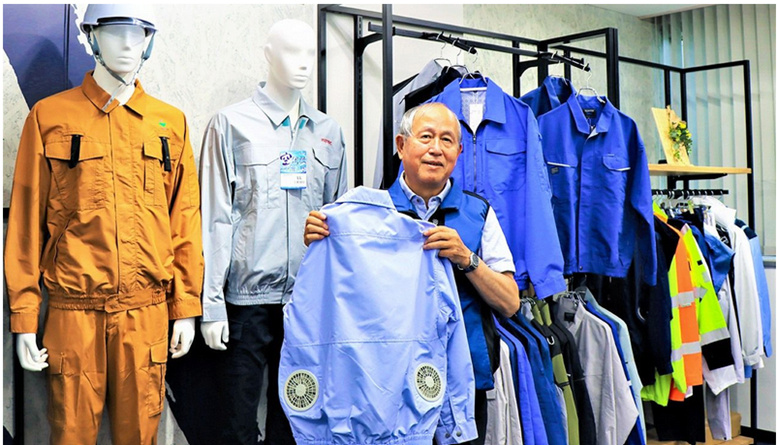
Climate change predicts more hot summer days each year. It is common to see on the streets of Japan during these hot months puffy jackets with fans to cool the wearer. Since it was introduced to the market in 2004, this “adaptive clothing” has become vital for people who work outdoors, now the technology is making its way into sportswear and fashion apparel as well.
The body's natural coolant
When the human brain senses a rise in temperature, it instructs the sweat glands to secrete sweat that cools the body as it evaporates. This sweating is the body's natural cooling mechanism. Air-conditioned clothing, which is now commonly seen on the streets of Japan during the hot summer months, amplifies this cooling effect. The back of the garment is equipped with two small fans that draw air in and blow it across the surface of the body to instantly evaporate the sweat.
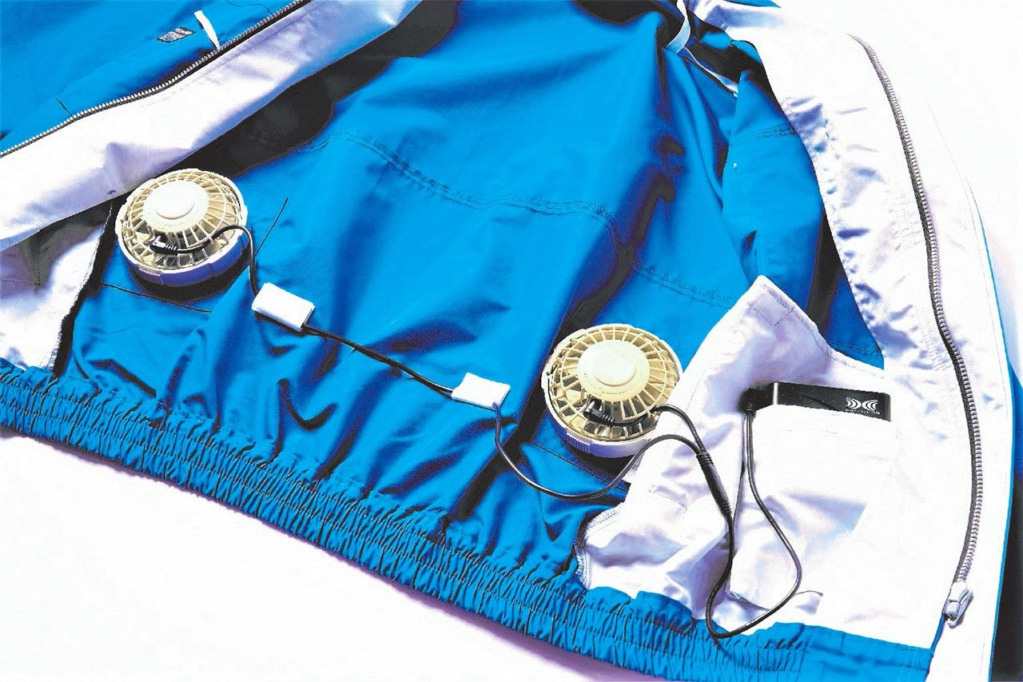
The internal structure of air-conditioned jackets. The interior pocket holds a rechargeable battery pack that powers the propellers. (Courtesy of Kochofuku)

Outside air is drawn into the garment, helping sweat to evaporate before escaping from the collar and cuffs. (Courtesy of Kochofuku)

Thermal image of the effect. The red parts of the image indicate higher temperatures. After 10 minutes with the fan off (left), the wearer becomes uncomfortably hot. Running the fan for 10 minutes (right) greatly cools the body. (Courtesy of Kochofuku)
Some ideas that seem geeky at first are straightforward once you understand the mechanism. But even after commercially producing adapted garments, the manufacturer faced many hurdles to gain widespread recognition and trust.
The clothing inspiration dates back nearly 30 years, to 1994.
In the words of the inventor, company chairman Ichigaya Hiroshi, “At that time, I was making cathode ray tube image quality measurement equipment for TV stations, and I visited Southeast Asia for sales. Thailand and Malaysia were experiencing a large-scale construction boom, and what I saw there got me thinking. It occurred to me that the amount of energy required to cool such buildings must be extraordinary. I wondered if it would be possible to devise refrigeration equipment that did not produce greenhouse gases.”
Ichigaya was 47 years old at the time. It's been three years since he started his own company, after taking early retirement from the famous Japanese company Sony Although he was doing well, he was worried about his future.
“The development of liquid crystal display or LCD technology was progressing faster than expected, and the disappearance of CRT displays seemed inevitable. I wondered if the new refrigeration equipment that helped reduce global warming could become a line of business to replace the cathode ray tube measuring equipment.”
Lesson from a giant
“I can't do what others can do, but I can do what they can't.”
These were the words Ichigaya wrote on the Sony entrance exam response sheet to a question about his strengths and weaknesses. He actually made a huge mistake on his exam, writing his answers one line below the correct one. But when it was discussed during the personal interview about this, he spoke eloquently of why the figures appear to be inverted in the mirror, and then he passed the entrance examination to the company.
“Since my childhood, I have been full of curiosity. I wondered why the candy box would get lighter when empty, but that wasn't the case with the batteries. When I was a kid, I used to think a lot about such things.”
In his last years of elementary school, he frequented the "Electronic City" in Akihabara , a neighborhood in Tokyo home to countless shops dealing in electronics and related components, and built his own microscope and telescope. The latter was a simple device: a roll of cardboard with a lens jammed at one end. The device was unique in that it was made with a single objective lens, replacing the "naked eye" capability of the ocular lens.
Ichigaya was deeply affected when he saw a Sony Trenton color TV in the famous Sony building in the Ginza district , which prompted him to study engineering at Waseda University and join Sony after graduation. There, he came under the tutelage of the extraordinary genius of Sony founder Ibuka Masaru.
Best memory is when Sony President Ibuka gave him a high prize for a flute that uses light from a cathode ray tube as a sound source, which he submitted to the company's invention competition. Ichigaya was transferred from the factory to the development department at the headquarters, where he was involved in the development of new electronic musical instruments. The product was not eventually released or commercialized, but encouragement from Chairman Ibuka supported the "inventor" Ichigaya even after he founded his own company.
The concept of absolute cooling
After careful consideration, Ichigaya came up with the main concept of achieving an energy-saving cooling mechanism by using water. His idea originated from the Uchimizu Japanese tradition of splashing water on the ground to cool off.
The energy used to produce heat of evaporation is closely related to global warming. With the spread of air conditioners, heat island phenomena have developed in urban areas. The water evaporates harmlessly and costs nothing. The effect may be minimal compared to air conditioners, but there is no doubt that water is the perfect coolant.
He realized that apart from spraying water, most current cooling systems use the power of evaporation—everything from portable fans and electric fans to air conditioners and refrigerators and even atomic reactors. The difference is what they use as a coolant. Fans rely on sweat, household appliances use alternative CFCs and other compounds made for refrigerants, and atomic reactors use river or sea water.
His thoughts then turned to water-cooled coolers, and he decided to experiment in a small space, building a dog house. At this point, I realize there is no need to cool the entire space — just cooling people is enough.
An exciting experience on the train
He soon designed clothes with a water-cooled radiator. It featured a water tank with a suction pump, tubes that removed heat through water evaporation, and used a fan to provide airflow. Ichigaya wore clothes on the trains, and carried an “Experiment in Progress” sign.
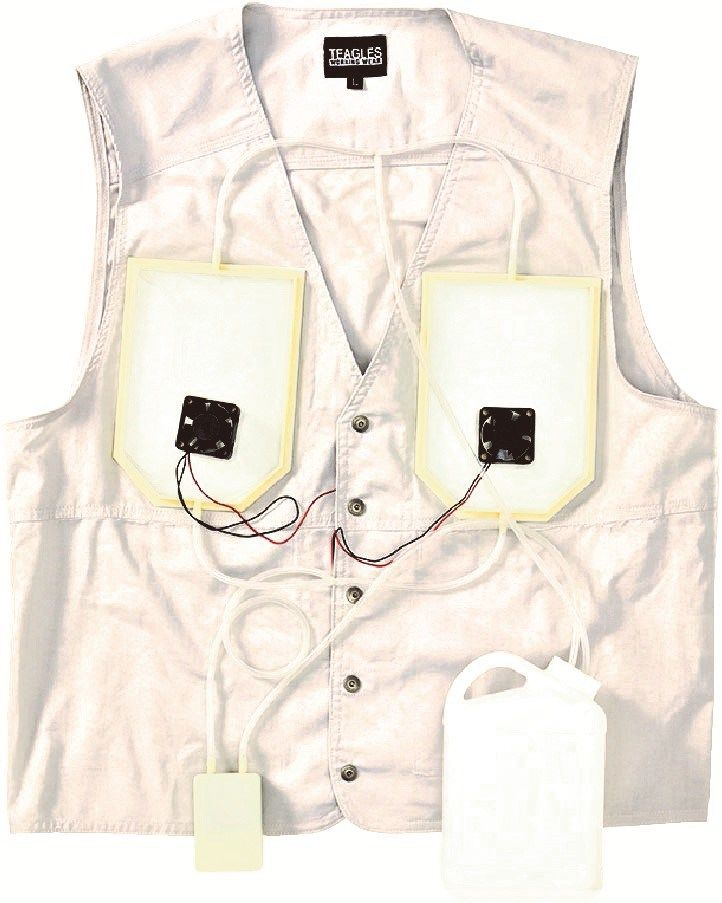
Ichigaya's 1999 model, the first prototype of his adapted outfit. A chest filter supplies water, while fans provide airflow. (Courtesy of Kochofuku)
“The passengers thought I was weird and looked at me suspiciously because of my appearance,” Ichigaya recalls with a laugh. “My daughter, who was then in high school, was with me on the train one day. She told me she was so embarrassed by my appearance and begged me to stop.”
The water tank was very heavy, and it leaked. In cool conditions, the device worked very well, but the effect was limited when it was very hot. It was a complete failure.
When he was thinking about how to solve the leakage problem, a genius idea occurred to him. “I realized that there is no need to use water, because the human body produces sweat when it is hot. I thought it would be possible to keep the body at an appropriate temperature by using a fan to evaporate the sweat.”

In the 2001 model, Ichigaya used commercially available miniature fans and a new mechanism to expel hot air from inside the clothes. (Courtesy of Kochofuku)

On the 2002 model year, a spacing grille was installed on the interior to prevent materials from sticking to the body and improve airflow. (Courtesy of Kochofuku)
Encouragement from fans
Sales of air-conditioned clothing began in 2004, six years after Ichigaya began his experiments. But sales were slow, at about 10,000 pieces a year.
“It was a product that had never been seen before, so there was nothing consumers could compare it to. Most importantly, the average person cannot understand wearing a jacket in the heat.”
But in Ichigaya's thinking, if people just try on his jacket, they will realize its benefits. But his appearance proved to be a bigger flaw than expected.
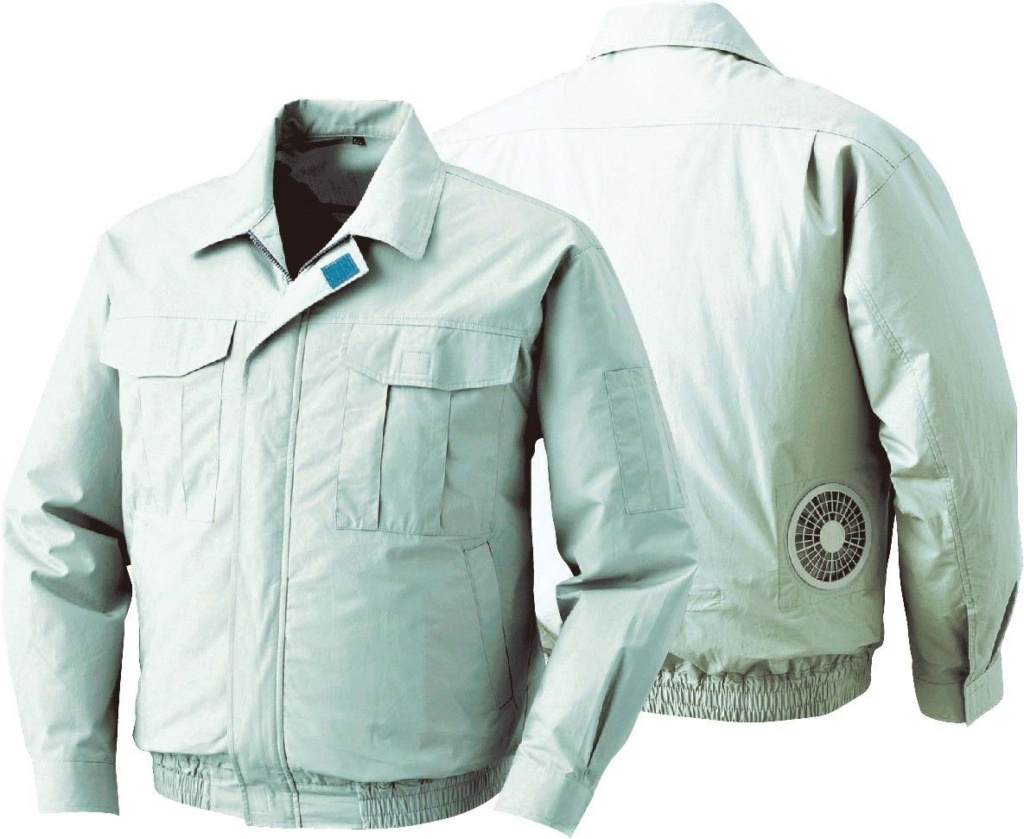
In 2004, Ichigaya released the first commercially available model, and expanded the fan units on the advice of a son. Unlike the previous version, the air is sucked in. (Courtesy of Kochofuku)
Meanwhile, his new venture was in trouble.
CRT metering equipment was an expensive product, costing 5 million yen per unit. In that industry he can sell three to five units per month. But producing air-conditioned clothes, at 10,000 yen apiece, was not easy at all. Faced with a cash flow crisis, even research into his finances has proven too little, too late. Banks refused additional financing, and he was threatened with bankruptcy.
But he did not resign himself to his fate, based on his firm conviction that there is no such thing as air-conditioned clothing to reduce the chance of heatstroke outdoors. Positive feedback from fans of air-conditioned clothing also contributed to its continuation.
One day, though, the company's call center filed a complaint they'll never forget. “Are you trying to kill my husband?” was the caller's opening remark. She said he bought three pieces of air-conditioned clothing, but all of them were damaged and broken during use on the job site. (At the time, many units failed when the power cable got stuck inside the casing.)
The information was passed on to Ichigaya, who phoned the woman's husband to apologize. He explained his understanding of the suffering that the man went through due to the failure of the fan in the scorching sun, because he also saw the same experience.
Hearing this, the man in turn thanked Ichigaya and encouraged him.
“I am a big fan of air-conditioned clothes. In the past, I have been hospitalized and given intravenous fluids to rehydrate several times, but not once since I started wearing air-conditioned clothing. I couldn't work a summer without it. So please keep up your work and don't give up! .”
Through this comment, Ichigaya realized that there were many people who needed air-conditioned clothing, and he felt responsible for meeting their needs. He began working on product improvements with Kurumizawa Takeo, the company's director in charge of technology.

The 2005 model was the first to use the current design. Improvements have been made to the fan installation. (Courtesy of Kochofuku)
In 2011, they were finally back on track. They solved the battery problems, and made lithium-ion batteries in their Chinese factory to use in place of dry cell batteries, thus greatly increasing runtime and airflow. Their reputation spread among construction workers across Japan, through word of mouth and over the Internet. Since 2012, the company has seen its sales double each year, reaching 1.2 million pieces in 2019, valued at 5.7 billion yen.
Recently, Kochofuku has been producing clothes in collaboration with a well-known fashion company. The use is no longer limited to construction workers; The jackets now have fans among athletes and more. Competitors appeared on the market, and today the air-conditioned clothing industry is worth 20 billion yen.

In August 2022, Kochofuku released men's apparel suitable for golf and other leisure activities, produced in collaboration with Takeo Kikuchi. (Courtesy of Kochofuku)
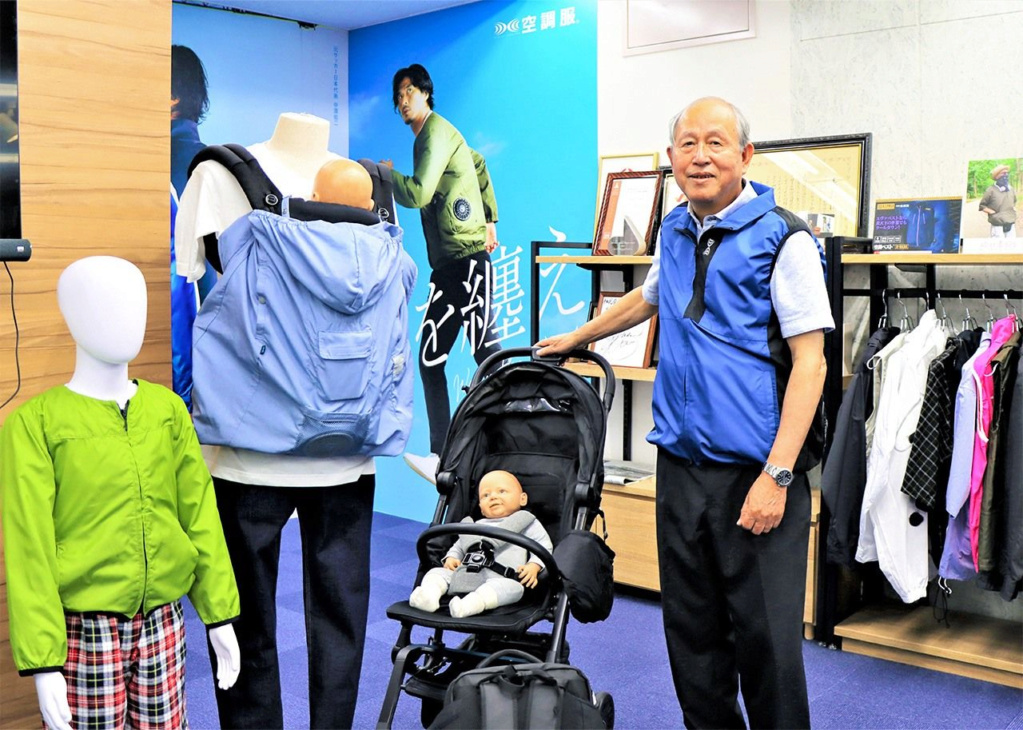
The company has expanded its range, developing strollers, backpacks, pillows, beds and other products that incorporate cooling mechanisms. Amano Hisaki.
Perseverance, commitment and determination to work work miracles
For Ishigaya, Ibuka Masaru’s words ring true: “Innovation is born when we cherish our foolish notions.”
The story of Ichigaya's invention shows how air-conditioned clothing is the embodiment of such a philosophy. It is the product of more than 20 years of continuous deliberation.
But Ichigaya believes that adapted clothing has not yet been perfected - it is still being developed. He claims to have many ideas that he has not yet been able to discuss. Taking his business to global markets is one of his next challenges.
“I want to keep coming up with ideas and evaluating my gut. I doubt I would have invented the idea of air-conditioned clothing if I were an air-conditioning or clothing professional. I don't start with the concept of "this is something I can do". “I want to create a lot of products by evaluating the perspective of ‘I wish I had something like this’ and the curiosity of ‘Why is it like this?’”
Source : websites

